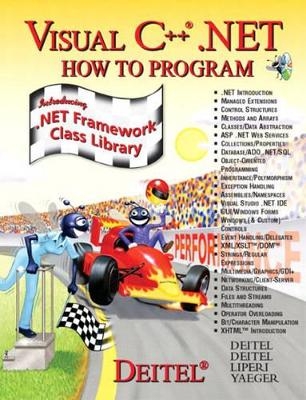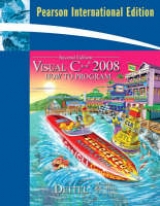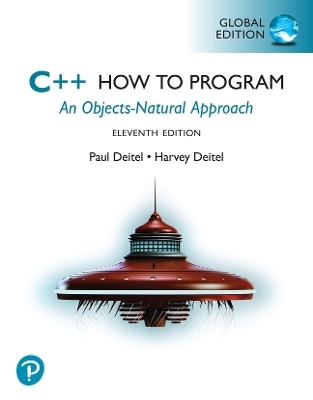
Visual C++.NET
Pearson
978-0-13-437377-5 (ISBN)
- Titel erscheint in neuer Auflage
- Artikel merken
Written by the authors of the world's best-selling introductory/intermediate C and C++ textbooks to directly correlate to Microsoft Visual C++. .NET 2003, this comprehensive book thoroughly examines Visual C++® .NET. Visual C++® .NET How to Program begins with a strong foundation in the introductory and intermediate programming principles students will need in industry, including fundamental topics such as arrays, functions and control statements.
Harvey M. Deitel is one of the world's leading computer science instructors and seminar presenters. Paul J. Deitel has taught programming at many of the world's leading companies. Together, they have authored numerous books and multimedia packages, and are principals of Deitel and Associates Inc., a leading global training and content-creation firm.
1. Introduction to .NET and Visual C++ .NET.
Introduction. History of the Internet and World Wide Web. World Wide Web Consortium (W3C). Extensible Markup Language (XML). Key Software Trend: Object Technology. Introduction to Microsoft .NET. Visual C++ .NET. .NET Framework and the Common Language Runtime. Web Resources.
2. Introduction to the Visual Studio .NET IDE.
Introduction. Visual Studio .NET Integrated Development Environment (IDE)Overview. Menu Bar and Toolbar. Visual Studio .NET Windows. Using Help. Simple Program: Displaying Text. Simple Program: Displaying Text and an Image.
3. Introduction to Visual C++ .NET Programming.
Introduction. Simple Program: Printing a Line of Text. Another Simple Program: Adding Integers. Memory Concepts. Arithmetic. Decision Making: Equality and Relational Operators.
4. Control Statements: Part 1.
Introduction. Algorithms. Pseudocode. Control Structures. if Selection Statement. if...else Selection Statement. while Repetition Statement. Formulating Algorithms: Case Study 1 (Counter-Controlled Repetition). Formulating Algorithms with Top-Down, Stepwise Refinement: Case Study 2 (Sentinel-Controlled Repetition). Formulating Algorithms with Top-Down, Stepwise Refinement: Case Study 3 (Nested Control Structures). Assignment Operators. Increment and Decrement Operators.
5. Control Statements: Part 2.
Introduction. Essentials of Counter-Controlled Repetition. for Repetition Statement. Examples Using the for Statement. switch Multiple-Selection Statement. do...while Repetition Statement. break and continue Statements. Logical Operators. Structured-Programming Summary.
6. Functions.
Introduction. Functions and Methods in Managed Extensions for C++. Math Class Methods. Functions. Function Definitions. Argument Promotion. Namespaces in Managed Extensions for C++. Value Types and Reference Types. Pointers and References. Passing Arguments: Pass-by-Value vs. Pass-by-Reference. Default Arguments. Random-Number Generation. Example: Game of Chance. Duration of Variables. Scope Rules. Recursion. Example Using Recursion: The Fibonacci Series. Recursion vs. Iteration. Function Overloading.
7. Arrays.
Introduction. Arrays. Declaring and Allocating Arrays. Examples Using Arrays. Passing Arrays to Functions. Sorting Arrays. Searching Arrays: Linear Search and Binary Search. Multidimensional Arrays.
8. Object-Based Programming.
Introduction. Implementing a Time Abstract Data Type with a Class. Class Scope. Controlling Access to Members. Initializing Class Objects: Constructors. Using Overloaded Constructors. Properties. Composition: Object Pointers as Data Members of Other Classes. Using the this Pointer. Garbage Collection. static Class Members. const Keyword and Read-Only Properties. Indexed Properties. Data Abstraction and Information Hiding. Software Reusability. Namespaces and Assemblies. Class View.
9. Object-Oriented Programming: Inheritance.
Introduction. Base Classes and Derived Classes. protected Members. Relationship Between Base Classes and Derived Classes. Example: Three-Level Inheritance Hierarchy. Constructors and Destructors in Derived Classes. Software Engineering with Inheritance.
10. Object-Oriented Programming: Polymorphism.
Introduction. Derived-Class-Object to Base-Class-Object Conversion. Type Fields and switch Statements. Polymorphism Examples. Abstract Classes. Case Study: Inheriting Interface and Implementation. __sealed Classes and Methods. Case Study: Payroll System Using Polymorphism. Case Study: Creating and Using Interfaces. Delegates. Operator Overloading.
11. Exception Handling.
Introduction. Exception Handling Overview. Example: DivideByZeroException. .NET Exception Hierarchy. __finally Block. Exception Properties. Programmer-Defined Exception Classes.
12. Graphical User Interface Concepts: Part 1.
Introduction. Windows Forms. Event-Handling Model. Control Properties and Layout. Labels, TextBoxes and Buttons. GroupBoxes and Panels. CheckBoxes and RadioButtons. PictureBoxes. Mouse Event Handling. Keyboard Event Handling.
13. Graphical User Interface Concepts: Part 2.
Introduction. Menus. LinkLabels. ListBoxes and CheckedListBoxes. ComboBoxes. TreeViews. ListViews. Tab Control. Multiple-Document-Interface (MDI) Windows. Visual Inheritance. User-Defined Controls.
14. Multithreading.
Introduction. Thread States: Life Cycle of a Thread. Thread Priorities and Thread Scheduling. Creating and Executing Threads. Thread Synchronization and Class Monitor. Producer/Consumer Relationship without Thread Synchronization. Producer/Consumer Relationship with Thread Synchronization. Producer/Consumer Relationship: Circular Buffer.
15. Strings, Characters and Regular Expressions.
Introduction. Fundamentals of Characters and Strings. String Constructors. String Chars Property, Length Property and CopyTo Method. Comparing Strings. Locating Characters and Substrings in Strings. Extracting Substrings from Strings. Miscellaneous String Methods. Class StringBuilder. StringBuilder Length and Capacity Properties, and EnsureCapacity Method. StringBuilder Append and AppendFormat Methods. StringBuilder Insert, Remove and Replace Methods. Char Methods. Card Shuffling and Dealing Simulation. Regular Expressions and Class Regex.
16. Graphics and Multimedia.
Introduction. Graphics Contexts and Graphics Objects. Color Control. Font Control. Drawing Lines, Rectangles and Ovals. Drawing Arcs. Drawing Polygons and Polylines. Advanced Graphics Capabilities. Introduction to Multimedia. Loading, Displaying and Scaling Images. Animating a Series of Images. Windows Media Player. Microsoft Agent.
17. Files and Streams.
Introduction. Data Hierarchy. Files and Streams. Classes File and Directory. Creating a Sequential-Access File. Reading Data from a Sequential-Access File. Random-Access Files. Creating a Random-Access File. Writing Data “Randomly” to a Random-Access File. Reading Data Sequentially from a Random-Access File. Case Study: A Transaction-Processing Program.
18. Extensible Markup Language (XML).
Introduction. XML Documents. XML Namespaces. Document Object Model (DOM). Document Type Definitions (DTDs), Schemas and Validation. Extensible Stylesheet Language and Xsl Transform. Internet and Web Resources.
19. Database, SQL and ADO .NET.
Introduction. Relational Database Model. Relational Database Overview: Books Database. Structured Query Language (SQL). ADO .NET Object Model. Programming with ADO.NET: Extracting Information from a Database. Programming with ADO .NET: Modifying Database Data. Reading and Writing XML Files. Internet and Web Resources.
20. Web Services.
Introduction. HTTP Request Types. Multi-Tier Architecture. Accessing Web Servers. Simple HTTP Transaction. ASP(Active Server Pages).NET. .NET Web Services Basics. Simple Object Access Protocol (SOAP)and Web Services. Publishing and Consuming Web Services. Session Tracking. Session Tracking in Web Services. Case Study: Temperature-Information Application. User-Defined Types in Web Services. Global XML Web Services Architecture (GXA).
21. Networking: Streams-Based Sockets and Datagrams.
Introduction. Establishing a Simple Server (Using Stream Sockets). Establishing a Simple Client (Using Stream Sockets). Client/Server Interaction with Stream-Socket Connections. Connectionless Client/Server Interaction with Datagrams. Client/Server Tic-Tac-Toe Using a Multithreaded Server.
22. Data Structures and Collections.
Introduction. Self-Referential Classes. Linked Lists. Stacks. Queues. Trees. Collection Classes.
A. Operator Precedence Chart.
B. Number System.
Introduction. Abbreviating Binary Numbers as Octal Numbers and Hexadecimal Numbers. Converting Octal Numbers and Hexadecimal Numbers to Binary Numbers. Converting from Binary, Octal or Hexadecimal to Decimal. Converting from Decimal to Binary, Octal or Hexadecimal. Negative Binary Numbers: Twos-Complement Notation.
C. ASCII Character Set.
D. Unicode.
Introduction. Unicode Transformation Formats. Characters and Glyphs. Advantages and Disadvantages of Unicode. Unicode Consortium's Web Site. Using Unicode. Character Ranges.
E. Introduction to XHTML: Part 1.
Introduction. Editing XHTML. First XHTML Example. W3C XHTML Validation Service. Headers. Linking. Images. Special Characters and More Line Breaks. Unordered Lists. Nested and Ordered Lists. Internet and Web Resources.
F. Introduction to XHTML: Part 2.
Introduction. Basic XHTML Tables. Intermediate XHTML Tables and Formatting. Basic XHTML Forms. More Complex XHTML Forms. Internal Linking. Creating and Using Image Maps. meta Elements. frameset Element. Nested framesets. Internet and Web Resources.
G. XHTML Special Characters.
H. XHTML Colors.
I. Bit Manipulation.
Introduction. Bit Manipulation and the Bitwise Operators. Class BitArray.
Bibliography.
Index.
| Erscheint lt. Verlag | 6.11.2003 |
|---|---|
| Sprache | englisch |
| Gewicht | 1896 g |
| Themenwelt | Mathematik / Informatik ► Informatik ► Programmiersprachen / -werkzeuge |
| ISBN-10 | 0-13-437377-4 / 0134373774 |
| ISBN-13 | 978-0-13-437377-5 / 9780134373775 |
| Zustand | Neuware |
| Haben Sie eine Frage zum Produkt? |
aus dem Bereich

